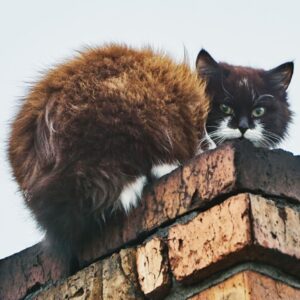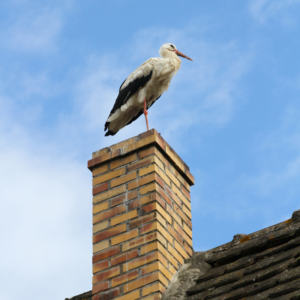If you find your fireplace cozy and inviting, you might not be surprised to learn that a variety of critters can view your chimney the same way. Birds, such as chimney swifts, or mammals, such as raccoons, bats, and squirrels, can all find their way into chimneys from time to time. When this happens, it’s important to take action for the wellbeing of both the animal and your home.
Why Are Animals in My Chimney Bad?
While the shelter your chimney provides may seem good to animals, it’s less than ideal for you.
- If you have an animal infestation, you may notice noise, smells, and debris like soot or nesting materials falling into your fireplace.
- Animals can cause damage to your furnace or fireplace system and create hazardous blockages that affect ventilation and increase the risk for uncontained fires or carbon monoxide poisoning.
- Animals can become trapped and die in the chimney, or can inadvertently enter your living space in an effort to escape.
- During the burning season, a noted animal infestation will interrupt the use of your home heating system.
Understandably, it’s alarming and inconvenient to find animals have taken up residence in your chimney. But fear not! We’re here to help you navigate the situation and, once the animals, nesting materials, and any droppings are removed, we can ensure that your chimney remains a creature-free zone.
What To Do if Animals Are In Your Chimney
Step 1: Have the Animal(s) Removed From the Chimney
 Your first call when you suspect or have confirmed that there’s an animal in your chimney should be to animal control. While your mind may jump to your trusted chimney professional, handling wild animals is an entirely different field requiring its own licensing, so they won’t be able to remove the animals – though they will be very helpful in clearing out your chimney and offering preventive solutions after the removal is complete.
Your first call when you suspect or have confirmed that there’s an animal in your chimney should be to animal control. While your mind may jump to your trusted chimney professional, handling wild animals is an entirely different field requiring its own licensing, so they won’t be able to remove the animals – though they will be very helpful in clearing out your chimney and offering preventive solutions after the removal is complete.
Animal control will have the expertise to know when and how to remove the animal humanely – and with the least possible impact to your home. Keep in mind, however, that immediate removal may not be possible in a few cases, such as in the case of chimney swifts, which are a protected species under the Federal Migratory Bird Treaty Act. This act makes it a federal offense to damage or remove chimney swift nests until after the hatchlings have left it. In this case, animal control will advise you to wait until the critters have left on their own.
Step 2: Have Your Chimney Swept
Once the animal has been removed (or, if federally protected, moved out for the season), it’s essential to have your chimney swept by a qualified technician. Animals in your chimney can leave behind debris such as twigs, leaves, feathers, droppings, or nests. It’s important to have your chimney inspected annually and swept frequently, but even if it had been swept recently prior to the infestation, you’ll want your chimney technician to lay eyes (and brushes) on it again. This ensures that, now that the animal is gone, your system is safe to use again.
A thorough chimney sweeping will not only eliminate the potential dangerous clutter your animal houseguest left behind, but also improve your chimney’s efficiency and airflow, leaving it ready to perform optimally once more. Checking that your chimney company is Chimney Safety Institute of America (CSIA) certified, licensed, and insured, will help ensure this job is done correctly, expertly, and with care.
Step 3: Invest in Preventive Measures to Protect Your Chimney
If you don’t currently have an animal in residence in your chimney, consider this step number one! Your chimney doesn’t have to be an animal hotel, and taking measures so it doesn’t become one will help safeguard your investment in your home – and spare you the hassle of animal infestation.
When you have a chimney that’s clean and animal-free, it’s time to take preventive steps to keep unwanted guests away. Our chimney technicians can provide valuable advice and practical solutions to effectively animal-proof your chimney. Here are some solutions they might recommend:
 Chimney Caps. Installing a sturdy chimney cap is an excellent first line of defense against critters seeking refuge in your chimney. Positioned on top of your chimney flue, chimney caps are designed to allow smoke and gases to vent while keeping animals, precipitation, and debris out. Your chimney professional can help you select a suitable chimney cap for your system and properly install it to help protect your chimney against the elements for years to come.
Chimney Caps. Installing a sturdy chimney cap is an excellent first line of defense against critters seeking refuge in your chimney. Positioned on top of your chimney flue, chimney caps are designed to allow smoke and gases to vent while keeping animals, precipitation, and debris out. Your chimney professional can help you select a suitable chimney cap for your system and properly install it to help protect your chimney against the elements for years to come.- Dampers. Chimney dampers are positioned in your flue and help control ventilation and maximize efficiency. Top-sealing dampers can also be helpful in keeping animals out by acting as a physical barrier.
It’s possible that your pro will have other suggestions, such as trimming overhanging tree branches that can act as pathways for animals to access your roof and chimney and reminding you to schedule your regular chimney inspections. Inspections help catch any signs of animal activity or potential entry points early on to spare you the headache involved with infestation or circumvent greater damage related to it.
Animal Problems? Let Us Help
Don’t let creatures dampen your fireplace or home heating appliance use and efficiency – there are steps you can take to respond to animal infestation and keep it from happening in the future, for the good of your chimney and the animals who could otherwise get stuck in it.
For quality services, trust in us. Dial 570-221-4113 or reach out to us online today.

Recent Comments